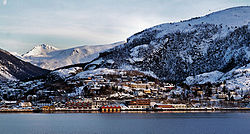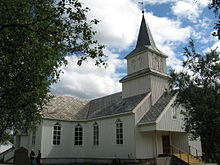Meløy Municipality
Meløy Municipality
Meløy kommune | |
|---|---|
 View of Ørnes in winter | |
 Nordland within Norway | |
 Meløy within Nordland | |
| Coordinates: 66°47′17″N 13°40′33″E / 66.78806°N 13.67583°E | |
| Country | Norway |
| County | Nordland |
| District | Salten |
| Established | 1884 |
| Administrative centre | Ørnes |
| Government | |
| • Mayor (2015) | Sigurd Stormo (Ap) |
| Area | |
| • Total | 873.83 km2 (337.39 sq mi) |
| • Land | 798.10 km2 (308.15 sq mi) |
| • Water | 75.73 km2 (29.24 sq mi) |
| • Rank | #128 in Norway |
| Population (2017) | |
| • Total | 6,435 |
| • Rank | #165 in Norway |
| • Density | 8.1/km2 (21/sq mi) |
| • Change (10 years) | |
| Demonym | Meløyfjerding[1] |
| Official language | |
| • Norwegian form | Bokmål |
| Time zone | UTC+01:00 (CET) |
| • Summer (DST) | UTC+02:00 (CEST) |
| ISO 3166 code | NO-1837[3] |
| Website | Official website |
Meløy is a municipality in Nordland county, Norway. It is part of the Salten traditional region. The administrative centre of the municipality is the village of Ørnes. Other villages include Eidbukta, Neverdal, Glomfjord, Halsa, Reipå, and Ågskardet.


The municipality is situated just to the north of the Arctic Circle on Norway's west coast. It encompasses the island of Meløya and some 700 other islands of various sizes around the Meløyfjorden, Glomfjorden, and Holandsfjorden in the south, along with a stretch of mainland coast.
The 874-square-kilometre (337 sq mi) municipality is the 128th largest by area out of the 422 municipalities in Norway. Meløy is the 165th most populous municipality in Norway with a population of 6,435. The municipality's population density is 8.1 inhabitants per square kilometre (21/sq mi) and its population has decreased by 3.4% over the last decade.[4]
General information
The municipality of Meløy was established on 1 January 1884 when the northern district of the municipality of Rødøy was separated to become the new municipality of Meløy. The initial population of Meløy was 2,696. The municipal borders have not changed since then.[5]
Name
The municipality (originally the parish) is named after the island of Meløya (Old Norse: Mjǫlva), since the first church (Meløy Church) was built there. The old name of the island is probably derived from mjǫl which means "flour" or "meal" (referring to fine sand on the beaches of the island). The last element øy which means "island" was added to the name around 1500. Historically, the name was spelled Melø.[6]
Coat-of-arms
The coat-of-arms is from modern times; they were granted on 7 December 1984. The arms show a yellow poppy plant (Papaver radicatum subglobosum) on a blue background. The village is near the second largest glacier in continental Norway, the Svartisen (black ice), and the plant is one of the plants growing closest to the ice. The colors symbolize the blue glacial ice and the yellow flowers.[7]
Churches

The Church of Norway has three parishes (sokn) within the municipality of Meløy. It is part of the Bodø domprosti (arch-deanery) in the Diocese of Sør-Hålogaland.
| Parish (Sokn) |
Church Name | Location of the Church |
Year Built |
|---|---|---|---|
| Fore og Meløy | Fore Church | Reipå | 1909 |
| Meløy Church | Meløya | 1867 | |
| Ørnes Church | Ørnes | 1990 | |
| Glomfjord | Glomfjord Church | Glomfjord | 1957 |
| Halsa | Halsa Church | Halsa | 1960 |
History


Meløy has been inhabited for many centuries and still possesses various relics from the Viking age. The Benkestok family, one of Norway's original noble families, established one of its seats at Meløy gård (farm) on the island of Meløya in the 16th century.
Due to the expansion of the community during the 19th century, it was split from its southern neighbour Rødøy in 1884. Its administrative centre was originally on Meløya, but it was later moved to the mainland coastal village of Ørnes. Ørnes is one of the stops on the route of the Hurtigruten (coastal express boat), with a notably scenic entrance via the fjord.
The second largest glacier in Norway, Svartisen, is a target for passenger visits. The mountains around Glomfjord are popular for fishing and hunting as well as skiing in the winter time.
Government
All municipalities in Norway, including Meløy, are responsible for primary education (through 10th grade), outpatient health services, senior citizen services, unemployment and other social services, zoning, economic development, and municipal roads. The municipality is governed by a municipal council of elected representatives, which in turn elect a mayor.
Municipal council
The municipal council (Kommunestyre) of Meløy is made up of 23 representatives that are elected to four year terms. Currently, the party breakdown is as follows:[8]
| Party name (in Norwegian) | Number of representatives | |
|---|---|---|
| Labour Party (Arbeiderpartiet) | 7 | |
| Progress Party (Fremskrittspartiet) | 3 | |
| Conservative Party (Høyre) | 5 | |
| Christian Democratic Party (Kristelig Folkeparti) | 2 | |
| Centre Party (Senterpartiet) | 4 | |
| Socialist Left Party (Sosialistisk Venstreparti) | 1 | |
| Liberal Party (Venstre) | 1 | |
| Total number of members: | 23 | |
Geography
The municipality of Meløy is a coastal community that includes many of the surrounding islands. Many parts of the mainland were fairly isolated until road tunnels were built during the 20th century that connected them to the rest of Norway. Some of the main islands of Meløy are Meløya, Bolga, Mesøya, Støtt, and Åmnøya. Åmnøya is connected to the mainland via the Brattsund Bridge. The other islands are all accessible by boat or ferry only. The Kalsholmen Lighthouse is located in the southwestern part of the municipality.
The Vestfjorden passes Meløy in the northwest, and the Meløyfjorden, Glomfjorden, and Holandsfjorden cut into the mainland from the west. The Saltfjellet–Svartisen National Park is located in the southeast in the Saltfjellet mountain range, surrounding the Svartisen glacier.
Economy
The industrial development—and thus the main contributor to the economic development and growth of the Meløy community—started around the time of World War I. It was based on electrical power production in then new Glomfjord power plant from water coming from the Svartisen glacier and the lake Storglomvatnet and gathered in the mountains. In the bottom of Glomfjorden, Norsk Hydro (today YARA) started out producing fertilizers in Glomfjord. A conglomerate of industries is found there today in Glomfjord Industry Park. The municipality's overall industries are some light industry, agriculture, forestry, fishing, salmon production, and tourism.
References
- ^ "Navn på steder og personer: Innbyggjarnamn" (in Norwegian). Språkrådet.
- ^ "Forskrift om målvedtak i kommunar og fylkeskommunar" (in Norwegian). Lovdata.no.
- ^ Bolstad, Erik; Thorsnæs, Geir, eds. (2023-01-26). "Kommunenummer". Store norske leksikon (in Norwegian). Kunnskapsforlaget.
- ^ Statistisk sentralbyrå (2017). "Table: 06913: Population 1 January and population changes during the calendar year (M)" (in Norwegian). Retrieved 2017-09-16.
- ^ Jukvam, Dag (1999). "Historisk oversikt over endringer i kommune- og fylkesinndelingen" (PDF) (in Norwegian). Statistisk sentralbyrå.
- ^ Rygh, Oluf (1905). Norske gaardnavne: Nordlands amt (in Norwegian) (16 ed.). Kristiania, Norge: W. C. Fabritius & sønners bogtrikkeri. p. 173.
- ^ Norske Kommunevåpen (1990). "Nye kommunevåbener i Norden". Retrieved 2008-11-24.
- ^ "Table: 04813: Members of the local councils, by party/electoral list at the Municipal Council election (M)" (in Norwegian). Statistics Norway. 2015.
External links
 Nordland travel guide from Wikivoyage
Nordland travel guide from Wikivoyage- Video from Engabreen • Svartisen



